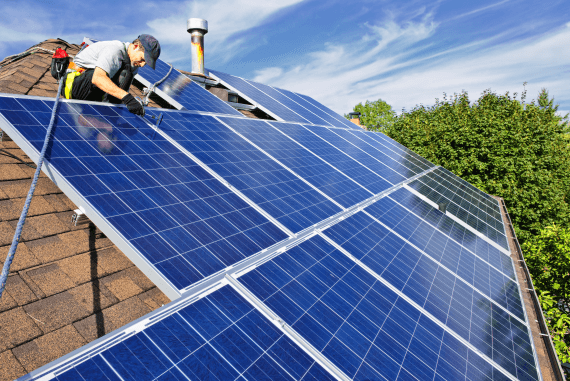- Home ››
- Health and Safety Training ››
- Environmental Health and Safety ››
- Energy ››
- Solar Power
Solar Power
Introduction

One of the most popular forms of renewable energy is solar power, where energy from the sun is harnessed for a particular use.
The most common method of achieving this is through solar panels, which convert light energy from the sun into the electricity needed to power machinery and equipment. Generating electricity in this manner means that the equivalent amount is not needed to be produced from a power station which burns fossil fuels such as coal or oil, and which would emit harmful emissions like carbon dioxide gas into the atmosphere. The more energy that can be generated through a "clean", renewable source such as solar power, the better it is for the environment.
Solar power does not just have to refer to electricity generation though. As well as light energy, the sun also radiates heat energy which can be used for heating and certain other actions such as evaporating water from salt pans or drying out fish for storage. The natural energy of the sun has been utilised in this way by mankind for thousands of years.
Despite humans putting to good use the energy of the sun for thousands of years, it was only in the last few decades that the technology was invented, in the form of photovoltaic cell, to convert solar energy into electricity. The sun now plays a significant role in our future electricity generation needs.
In fact, this role is increasing in significance thanks to the dwindling supplies of fossil fuels remaining, and the understanding that toxic emission levels must be reduced soon to slow down the detrimental impact upon the planet and the climate. As a result, solar power and renewable energy is a key component of any environmental education course or programme that is provided, either for individuals or employees within a businesses.
Advantages of Solar Power
The biggest advantage of solar power, as mentioned above, is the ability to generate electricity without having to use natural resources that have to be mined out of the ground. The mining and extraction process can cause serious environmental impacts such as habitat loss, and the burning of these fossil fuels will release harmful gases.
Even if a person or company manager does not care about the environmental benefits, generating your own solar power will save money, which can be the only reason some people need to give the go ahead to the installation process. Although there may be a high initial cost for buying and installing the solar panels (which may be offset in certain countries through government grants and environmental initiatives) in the long term there will be significant savings to be made on their energy bills. There is also usually the option to sell any surplus electricity generated back to the grid.
Compared to other forms of electricity generation, the maintenance costs are remarkably low once the whole system has been installed. The lack of any moving parts means that apart from keeping the panels clean so that they can absorb the sunlight, there is very little maintenance work that needs to be done.
Limitations and Disadvantages of Solar Power
One of the biggest downsides of solar power is that it requires the sun to be shining for maximum efficiency, which means at night it will be useless and on cloudy days the amount of energy absorbed will be severely reduced. In countries with cooler climates, it is difficult to rely on solar energy, which can make it hard for many people to justify the cost of installing solar panels. Solar energy generated during the day can be stored in batteries for use at night, but these are expensive and take up a lot of room, although prices and battery sizes are coming down as the technology improves.
The generation of electricity in a useful amount from sunlight requires large photovoltaic panels to be installed which are not only expensive, but can look unsightly and spoil the aesthetics of a building or location. As with other forms of renewable energy, the initial cost of construction can be prohibitive and dissuade many homes and businesses from installing solar panels and taking advantage of solar energy.
Although opinions will differ, many people find these large solar panels mounted on roofs unsightly and out of keeping with the look of the rest of the town or village. Many methods of renewable energy generation do unfortunately require rather large and unsightly structures to operate. Consequently, visual aspects are a common criticism of new renewable energy projects, with the most frequent example being the installation of gigantic wind turbines on the tops of hills in picturesque countryside or in the sea just off the shoreline.
Fossil fuel and nuclear power stations produce a tremendous amount of electricity. Getting anywhere near the equivalent output requires a huge area to be covered by solar panels, which is often impractical. Whilst it would be fantastic to cut all toxic gas emissions from power stations and have all electricity produced through wind or solar means, at present it is not practical to do this. The amount of land required, and the subsequent destruction of habitat, which would be required to accommodate all these structures would in some ways be counterproductive if the overall goal is to safeguard the environment and natural world. The technology is constantly improving though, and as more and more electricity can be produced from, say, one square metre of a solar panel, the fewer panels will be needed and the less space will need to be taken up (or the same quantity can produce more and more electricity in the future).
Certain types of solar panels require elements and raw materials which still have to be mined out of the ground. Plus of course there will still be some pollution directly associated with the manufacture and transportation of all these solar panels. These amounts and any negative impact upon the environment will be more than offset by the benefits produced during the solar panel’s lifetime. See the section entitled "Using Some Materials Now to Save a Great Amount in the Future" in the article Assessing Environmental Costs and Benefits for more information on how a short-term negative impact can be worth it in the long run.
Summary of the Advantages and Disadvantages of Solar Power
Advantages:
- A clean and renewable source of energy
- Will save money in the long term
- Very little maintenance work required
- Can bring power to rural parts of come countries where the national electricity grid does not reach
Disadvantages:
- Can be expensive to install
- Can look ugly on roofs or require large tracts of land
- Efficiency and power generation significantly reduced on cloudy, dark days
- A huge number need to be installed to generate the equivalent amount of electricity as a fossil fuel or nuclear power station
- Not entirely free from pollution or environmental damage for the raw material gathering or construction process, but still far better for the environment overall despite this

